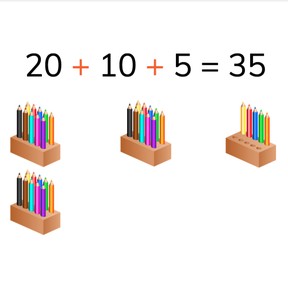
Addition to 100 with three or more simple numbers
Learn to add to 100 using three or more simple numbers, namely 10s and 5s.



8,000 schools use Gynzy
92,000 teachers use Gynzy
1,600,000 students use Gynzy
General
Students learn to add to 100 using three or more simple numbers, namely 10s and 5s.
Common core standard(s)
2.NBT.B.6
2.OA.A.1
Relevance
It is important to be able to add to 100, so you can determine totals.
Introduction
P.I.Napple, A.Pple, and B.A.Nana are walking home. How far is it to their house? They all start at 0. As they walk, numbers are added. Uncover the number to add and determine what the total is to get them home. How many steps does it take each fruit?
Development
Discuss the importance of adding to 100 with students. The learning goal will be explained in three ways, visually, in the abstract, and as story problems. You can navigate using the menu in the bottom right of the page. Determine which method is best suited to your class or use them all.
With the visual method first start by counting how many objects per group. You should count 50, 10 and 5. Then add these numbers. Check that students can solve the two example addition problems given. Explain to students that there are different ways to calculate an addition problem with multiple addends. As an example, take 20+15+5. Explain that you can first add 20+15 and then add the last 5. Show other possibilities. Show that you can add 15+5, and then add the last 20. Ask which students think is easier, but emphasize that students should choose the method that is easiest for them. Check that students are able to solve the given exercises. Next, students are instructed on how to solve with four addends. Show both methods. Show that you choose two addends that form an easy number to work with, like 20+10 and 15+5. Add the totals of these addends together to find the total. Check that students are able to solve addition problems with four addends. The next addition problem is in a table. Explain that the four numbers in the four boxes represent an addition problem. The question mark is where the answer should be. Show which addends to add together. In this case 20&40 and 25&15 are useful to add together. Calculate the total with the students. Show that you can also solve the problem in different ways. Check that students are able to solve addition problems in table form. Finally explain the steps of solving a story problem to students. Have them use the steps to solve a story problem. Check that students are able to solve a story problem.
Check that students are able to add to 100 using three or more simple numbers by asking the following questions:
- Why is it useful to be able to add to 100?
- Which method do you use to add to 100 with three or more simple numbers?
Guided practice
Students first start with an addition problem with visual support. They then are given an addition problem without visual support and finally a story problem to solve.
Closing
Check that students have understood the goal by asking which method they like best for adding multiple simple numbers to 100. Emphasize that it is a personal choice and that every student is different. A trio of addition problems is given, one visual, one abstract, and one story to check that students are able to transition between skills. Finally students finish with fruit-addition problems. Every fruit type is given a different value. They are listed to the left. The pineapple is 50. The task can be done as a class or in pairs. Example: orange (35)+ apple(15)+ strawberry(5) = 55
Teaching tips
Students that have difficulty with adding to 100 with multiple simple numbers can practice skip counting in 10s to 100. They can use the number line as visual support. They might also be supported by the use of MAB-blocks or other manipulatives.
Instruction materials
Optional: MAB blocks or manipulatives, number line
The online teaching platform for interactive whiteboards and displays in schools
Save time building lessons
Manage the classroom more efficiently
Increase student engagement
Discover more!
About Gynzy
Gynzy is an online teaching platform for interactive whiteboards and displays in schools.
With a focus on elementary education, Gynzy’s Whiteboard, digital tools, and activities make it easy for teachers to save time building lessons, increase student engagement, and make classroom management more efficient.



